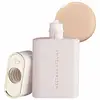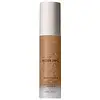Westman Atelier Vital Skincare Complexion Drops Versus Rose Inc Skin Enhance Luminous Skin Tint Serum Foundation
What's inside
What's inside
 Key Ingredients
Key Ingredients

 Benefits
Benefits

 Concerns
Concerns

 Ingredients Side-by-side
Ingredients Side-by-side

Squalane
EmollientWater
Skin ConditioningPersea Gratissima Oil
Skin ConditioningPunica Granatum Seed Oil
EmollientMica
Cosmetic ColorantPentylene Glycol
Skin ConditioningCamellia Japonica Seed Oil
EmollientPolyglyceryl-3 Polyricinoleate
EmulsifyingSorbitan Isostearate
EmulsifyingPropanediol
SolventHelianthus Annuus Seed Oil
EmollientPanax Ginseng Root Extract
EmollientZingiber Officinale Root Extract
MaskingOryza Sativa Extract
AbsorbentOryza Sativa Germ Extract
EmollientBisabolol
MaskingDisteardimonium Hectorite
StabilisingGlycine Soja Oil
EmollientGossypium Hirsutum Seed Oil
Skin ConditioningPrunus Amygdalus Dulcis Oil
Skin ConditioningTriticum Vulgare Germ Oil
EmollientZea Mays Germ Oil
Emollient4-T-Butylcyclohexanol
MaskingGlyceryl Caprylate/Caprate
EmollientAluminum Hydroxide
EmollientPolyglyceryl-3 Diisostearate
EmulsifyingDimer Dilinoleyl Dimer Dilinoleate
EmollientTin Oxide
AbrasiveSodium Lauroyl Glutamate
Lysine
Skin ConditioningMagnesium Chloride
Tocopherol
AntioxidantCI 77891
Cosmetic ColorantIron Oxides
CI 77491
Cosmetic ColorantCI 77492
Cosmetic ColorantCI 77499
Cosmetic ColorantSqualane, Water, Persea Gratissima Oil, Punica Granatum Seed Oil, Mica, Pentylene Glycol, Camellia Japonica Seed Oil, Polyglyceryl-3 Polyricinoleate, Sorbitan Isostearate, Propanediol, Helianthus Annuus Seed Oil, Panax Ginseng Root Extract, Zingiber Officinale Root Extract, Oryza Sativa Extract, Oryza Sativa Germ Extract, Bisabolol, Disteardimonium Hectorite, Glycine Soja Oil, Gossypium Hirsutum Seed Oil, Prunus Amygdalus Dulcis Oil, Triticum Vulgare Germ Oil, Zea Mays Germ Oil, 4-T-Butylcyclohexanol, Glyceryl Caprylate/Caprate, Aluminum Hydroxide, Polyglyceryl-3 Diisostearate, Dimer Dilinoleyl Dimer Dilinoleate, Tin Oxide, Sodium Lauroyl Glutamate, Lysine, Magnesium Chloride, Tocopherol, CI 77891, Iron Oxides, CI 77491, CI 77492, CI 77499
Water
Skin ConditioningHexyl Laurate
EmollientGlycerin
HumectantPentylene Glycol
Skin ConditioningOctyldodecanol
EmollientSqualane
EmollientTamarindus Indica Seed Gum
Emulsion StabilisingJasminum Sambac Leaf Cell Extract
MaskingMangostin
Skin ConditioningAcetyl Tetrapeptide-2
Skin ConditioningSodium Hyaluronate
HumectantTocopherol
AntioxidantAlcaligenes Polysaccharides
EmollientDisteardimonium Hectorite
StabilisingAmodimethicone
Carbomer
Emulsion StabilisingMagnesium Chloride
Trisodium Ethylenediamine Disuccinate
Sodium Lauroyl Glutamate
Helianthus Annuus Seed Oil
EmollientPropylene Carbonate
SolventAluminum Hydroxide
EmollientGlucose
HumectantLysine
Skin ConditioningCaprylyl Glycol
EmollientBenzyl Alcohol
PerfumingSodium Hydroxide
BufferingCitric Acid
BufferingMica
Cosmetic ColorantCI 77891
Cosmetic ColorantIron Oxides
Water, Hexyl Laurate, Glycerin, Pentylene Glycol, Octyldodecanol, Squalane, Tamarindus Indica Seed Gum, Jasminum Sambac Leaf Cell Extract, Mangostin, Acetyl Tetrapeptide-2, Sodium Hyaluronate, Tocopherol, Alcaligenes Polysaccharides, Disteardimonium Hectorite, Amodimethicone, Carbomer, Magnesium Chloride, Trisodium Ethylenediamine Disuccinate, Sodium Lauroyl Glutamate, Helianthus Annuus Seed Oil, Propylene Carbonate, Aluminum Hydroxide, Glucose, Lysine, Caprylyl Glycol, Benzyl Alcohol, Sodium Hydroxide, Citric Acid, Mica, CI 77891, Iron Oxides
 Reviews
Reviews

Alternatives
Ingredients Explained
These ingredients are found in both products.
Ingredients higher up in an ingredient list are typically present in a larger amount.
Aluminum Hydroxide is a form of aluminum. It can be naturally found in nature as the mineral gibbsite. In cosmetics, Aluminum Hydroxide is used as a colorant, pH adjuster, and absorbent.
As a colorant, Aluminum Hydroxide may add opacity, or reduce the transparency. Aluminum hydroxide is contains both basic and acidic properties.
According to manufacturers, this ingredient is an emollient and humectant. This means it helps hydrate the skin.
In medicine, this ingredient is used to help relieve heartburn and help heal ulcers.
There is currently no credible scientific evidence linking aluminum hydroxide in cosmetics to increased cancer risk.
Major health organizations allow the use of aluminum hydroxide in personal care products and have not flagged it as a carcinogenic risk at typical usage levels.
Learn more about Aluminum HydroxideCi 77891 is a white pigment from Titanium dioxide. It is naturally found in minerals such as rutile and ilmenite.
It's main function is to add a white color to cosmetics. It can also be mixed with other colors to create different shades.
Ci 77891 is commonly found in sunscreens due to its ability to block UV rays.
Learn more about CI 77891Disteardimonium Hectorite comes from the clay mineral named hectorite. It is used to add thickness to a product.
It can also help stabilize a product by helping to disperse other ingredients.
Hectorite is a rare, white clay mineral.
Learn more about Disteardimonium HectoriteHelianthus Annuus Seed Oil is the oil derived from the seeds of a Sunflower. Sunflower seed oil is non-fragrant. It is an emollient, meaning it helps to soften the skin.
Sunflower seed oil contains many fatty acids. The fatty acids found in sunflower seeds include (from highest amount to least): linoleic acid, myristic acid, palmitic acid, stearic acid, arachidic acid, oleic acid, and linolenic acid.
These fatty acids help the skin create ceramides. Ceramides play a role in repairing the skin barrier.
Helianthus Annuus Seed Oil helps moisturize the skin. This in turn helps the skin look more rejuvenated and smoother.
Sunflowers are rich in vitamin E.
Historians believe Indigenous cultures of North America domesticated sunflowers before corn. Thus they relied on sunflower oil for a variety of uses. One such use is moisturizing skin and hair.
Sunflower seed oil may not be fungal acne safe. We recommend speaking with a professional if you have any concerns.
Learn more about Helianthus Annuus Seed OilLysine is an essential amino acid. Your body is unable to produce it naturally and we mainly get lysine from food sources.
Our bodies use lysine for growth and tissue repair. The skin uses amino acids as a precursor for building protein, and therefore keratins, collagen and elastin.
We don't have a description for Magnesium Chloride yet.
Mica is a naturally occurring mineral used to add shimmer and color in cosmetics. It can also help improve the texture of a product or give it an opaque, white/silver color.
Serecite is the name for very fine but ragged grains of mica.
This ingredient is often coated with metal oxides like titanium dioxide. Trace amounts of heavy metals may be found in mica, but these metals are not harmful in our personal products.
Mica has been used since prehistoric times throughout the world. Ancient Egyptian, Indian, Greek, Roman, Aztec, and Chinese civilizations have used mica.
Learn more about MicaPentylene glycol is typically used within a product to thicken it. It also adds a smooth, soft, and moisturizing feel to the product. It is naturally found in plants such as sugar beets.
The hydrophilic trait of Pentylene Glycol makes it a humectant. As a humectant, Pentylene Glycol helps draw moisture from the air to your skin. This can help keep your skin hydrated.
This property also makes Pentylene Glycol a great texture enhancer. It can also help thicken or stabilize a product.
Pentylene Glycol also acts as a mild preservative and helps to keep a product microbe-free.
Some people may experience mild eye and skin irritation from Pentylene Glycol. We always recommend speaking with a professional about using this ingredient in your routine.
Pentylene Glycol has a low molecular weight and is part of the 1,2-glycol family.
Learn more about Pentylene GlycolSodium Lauroyl Glutamate is the sodium salt from the lauric acid of glutamic acid.
It is a surfactant and helps cleanse the skin. Surfactants gather oil, dirt, and other pollutants from your skin so they may be washed away easily.
Squalane is an emollient that helps the skin hold onto moisture. It's an oily liquid that occurs naturally in certain types of fish and plant oils.
Because squalane boosts hydration in the skin, it also comes with plenty of benefits: it is an antioxidant and can help fight free radicals and skin damage. Squalane is also found to have a detoxifying effect when applied.
Squalane comes from squalene, which occurs naturally within the sebum of our skin. It is one of the oils our skin produces to keep itself hydrated. Squalane is the hydrogenated version of squalene and has a longer shelf life.
Research shows that squalane is non-irritating (even at 100% concentration).
In general, it's a fantastic ingredient. It does a great job at hydrating the skin, and it's suitable for those with sensitive skin.
The source of squalane may impact malassezia / fungal acne. This is because olive oil derived squalane can contain impurities such as fatty acids and plant waxes. Sugarcane derived squalane is recommended for anyone with malassezia concerns.
Is squalane vegan?
This depends on the source. Squalane can be derived from both plants and animals. Most squalane used in skincare comes from plants.
Please note: the source of squalane is only known if disclosed by the brand. We recommend reaching out to the brand if you have any questions about their squalane.
Read more about squalene with an "e".
Is squalane an oil?
Squalane is often called an oil, but it’s technically not; it’s a hydrocarbon, meaning it’s only made of carbon and hydrogen, unlike true oils which are triglycerides made of fatty acids and glycerol.
The term “oil-free” isn’t regulated, so companies can define it however they want. Some exclude all oils, while others just avoid mineral oil or comedogenic oils.
While some people avoid oils thinking they cause breakouts, the right kind of oil (or oil-like ingredient like squalane) can actually help balance and hydrate your skin. It’s worth testing out simple oils or squalane to see what works best for your skin.
Learn more about SqualaneTocopherol (also known as Vitamin E) is a common antioxidant used to help protect the skin from free-radicals and strengthen the skin barrier. It's also fat soluble - this means our skin is great at absorbing it.
Vitamin E also helps keep your natural skin lipids healthy. Your lipid skin barrier naturally consists of lipids, ceramides, and fatty acids. Vitamin E offers extra protection for your skin’s lipid barrier, keeping your skin healthy and nourished.
Another benefit is a bit of UV protection. Vitamin E helps reduce the damage caused by UVB rays. (It should not replace your sunscreen). Combining it with Vitamin C can decrease sunburned cells and hyperpigmentation after UV exposure.
You might have noticed Vitamin E + C often paired together. This is because it is great at stabilizing Vitamin C. Using the two together helps increase the effectiveness of both ingredients.
There are often claims that Vitamin E can reduce/prevent scarring, but these claims haven't been confirmed by scientific research.
Learn more about TocopherolWater. It's the most common cosmetic ingredient of all. You'll usually see it at the top of ingredient lists, meaning that it makes up the largest part of the product.
So why is it so popular? Water most often acts as a solvent - this means that it helps dissolve other ingredients into the formulation.
You'll also recognize water as that liquid we all need to stay alive. If you see this, drink a glass of water. Stay hydrated!
Learn more about WaterThis ingredient is a combination of red, black, and yellow iron oxide pigments. This combination of colors is usually found in foundation, because it results in a "skin" color.